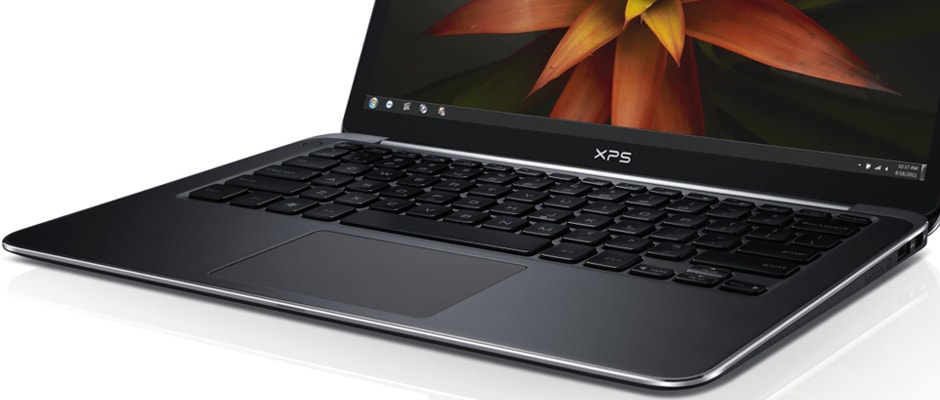Overview
Design & Usability
No frustrations—but no real praise either.
The XPS 13's touchpad has a glass finish that's very smooth to the touch and allows for easy navigation. It's also highly customizable, allowing for changes in scrolling speed, multitouch gestures, and how resilient the pad is to accidental palm touches. Even with the latter feature enabled, the pad is placed fairly close to the keyboard, so you'll need to be mindful of your palms.
We thought the keyboard was pretty good, though. The keys provided satisfying tactile feedback and didn't require a lot of pressure. The keyboard is also backlit, which should help users find infrequently-used keys in the dark.
{{photo_gallery "design"}}
Performance & Features
Great engineering at work
The XPS 13 features a solid-state drive with a 256 GB capacity. The laptop also comes with 4GB of DDR3 RAM. The four ports include a Mini DisplayPort, a 3.5mm audio input, and one each of USB 2.0 and 3.0.
In performance testing, this machine scored a PC Mark 7 rating of 3876. That's significantly higher than other cheaper laptops based on the slower Intel i5 processor, such as the Asus UX31E (3405) or the Lenovo U330s (3449). Geekbench provides a good measure of the raw ability of a laptop to crunch numbers, and the XPS 13 did well here too, with a rating of 7344. For comparison, the Acer Aspire S3 (which also has an Intel i7 processor) had a rating of 6673.
And what a speedy worker! With programs such as Photoshop, the XPS 13 zipped through in just under 13 seconds. Again, the cheaper laptops did not do as well, typically taking about 17 seconds to perform the same task. We also had the laptop transcode a movie, and it converted our test movie from HD to SD resolution in just under 170 seconds. That is quicker than models with the slower i5 processor, such as the Lenovo U300s (which took 216 seconds) and the Asus UX31E, which took just over 190 seconds.
On the down side, in Excel, this laptop took 7.8 seconds to make its way through our complicated spreadsheet. That's quicker than the HP Folio's 8.07 seconds, but slower than the Asus Zenbook's 6.9 seconds.
Conclusion
A design ethic that revolves around speed and power
The XPS 13 we tested carried an Intel Core i7-2637M processor with 4 GB of memory and 256 GB of storage. Along with its charger, the unit weighs in at 57.55 ounces, and comes with a $1299 price tag.
Testing proves that the XPS 13 is a powerful machine. It ranks amongst the top laptops we've tested thus far in every category. Though very nimble, it does have some faults, though. The screen has a fairly limited viewing angle, for example, and the battery life stinks. Also, the surface of the laptop may get too hot to touch, even before the battery dies.
Considering all its faults, we still liked the XPS 13. We can forgive design flaws, since this machine packs power like laptops twice its weight. Ranging in price from $999-1499, the XPS 13 is good value for money.
Introduction
The results are clear: This is one powerful machine.
PC Mark
Blows competition out of the water
The XPS 13 posted some excellent scores in our performance tests, achieving a PC Mark 7 rating of 3876. That's significantly higher than other cheaper laptops based on the slower Intel i5 processor, such as the Asus UX31E (3405) or the Lenovo U330s (3449).
Gaming
Kids, this is how it's done.
To test the XPS 13's ability to play current generation games, we did a real world test using Portal 2. Judged purely on game performance, this ultrabook is king of the hill.
Under the lowest settings, we flew around the room at 116.64 frames a second. That score even beats the significantly more expensive Macbook Pro, which managed 111.27 frames a second. Ramping up the settings to their utmost limit did not faze the XPS 13. The game still ran fairly smooth at 27.31 frames a second. In this race, the Macbook Pro did manage to beat the XPS 13, with 30.8 frames a second.
Meet the tester
Richard Baguley is a veteran writer who has written about technology ranging from Alphabet to Zip file utilities. He has contributed to pretty much every major tech publication, including Amiga Format Magazine, PC World, Wired, CNET, Toms Guide, Forbes, and many others. He lives in the Boston metro area with his wife, dog, and an indeterminate number of cats.
Checking our work.
Our team is here for one purpose: to help you buy the best stuff and love what you own. Our writers, editors, and lab technicians obsess over the products we cover to make sure you're confident and satisfied. Have a different opinion about something we recommend? Email us and we'll compare notes.
Shoot us an email


